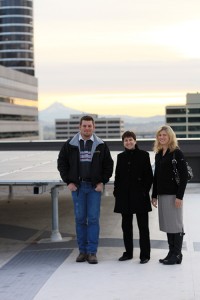Lincoln Hall, home to Portland State’s School of Fine and Performing Arts, emerges from a $31 million transformation as the university’s first platinum-certified LEED building. The renovation took a little more than two years and is nearing completion.
Funding for the deferred maintenance project came from the state legislature and federal economic stimulus packages.
The renovation was part of a massive project to upgrade the building’s seismic codes and mechanical systems, remove hazardous materials and live up to the university’s reputation as a leader in sustainability.

The original goal of the project was LEED gold certification, but as the project neared completion the building was teetering very close to platinum. PSU approached donors and additional funds were acquired, enabling the purchase and installation of 234 solar panels on the roof of the building, which secures LEED platinum certification. The panels will provide 2.9 percent of the building’s energy needs.
Energy efficient windows were also installed throughout Lincoln Hall. Troy Boardman,the superintendent for the contracting firm Howard S. Wright, which oversaw the renovation, said the windows were 100 percent manufactured in Oregon and installed by Oregonians.
Boardman said the biggest challenge faced during the project was having to reshore the building for the seismic retrofit. The hall had to be supported while the 60-foot beams were installed, as the building was occupied while the retrofit took place.
Ambient light now pours into the building from light wells that, in the ’70s, were walled in to create more storage space. Installing the seismic beams meant that the storage spaces had to be ripped out; this allowed the construction team to reopen the old skylights, flooding the building with natural light all the way down to the first floor.
Barbara Sestak, dean of the School of Fine and Performing Arts, attributes the success of the renovation to the collaborative efforts of architects, contractors, facilities and the university. By working together to resolve issues along the way, the team was able to save money and preserve some of the history of the building, which was constructed in 1911.
For example, the first plan called for completely removing the original stairs. The architects devised a way to hang the stairs while the seismic upgrades were completed, saving a significant amount of money and keeping an original feature intact.
Sestak feels the most exciting outcome of the renovation was “being able to grab academic space from areas formerly occupied by mechanical equipment.”
Removing outdated mechanical rooms during the systems upgrade enabled the transformation of these spaces into practice rooms, an acting studio, a computer lab for the music department and performance spaces.
A sleek new lobby on Southwest Broadway increases visibility and accessibility, giving a more inviting atmosphere to the building and the university, which “previously turned its back on the street,” Sestak said.
The final phase of the renovation will depend on an additional fundraising project that has a goal of raising $4 million. This money will go toward adding a three-story glass tower to the existing structure.
Sestak explained that the tower addition will allow several exciting changes to take place—changes which will greatly enhance the performing arts programs. The first floor will include new green rooms for visiting guest artists. Sestak said the existing green rooms are very small and do not represent the university well to the many international artists who perform at the hall throughout the year.
On the second floor, a new dance studio will enable the school to bring back the dance major—a program cut in the ’90s due to state budget cuts. The acting studios will be moved from their existing location to the third floor of the tower. The current acting studio will become a black box theater with approximately 60 seats. A new theater space will allow the opera program to have more rehearsal and performance time in the main concert hall, which they currently share with the theater department.
According to Kristin Coppola, assistant vice president of the PSU major gifts department, fundraising for the tower is a major priority for the university.
“This project is so important to PSU,” Coppola said, “because renovating Lincoln Hall and building the glass tower is another step toward having our exciting programs reflected in our physical space.”
